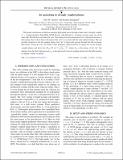| dc.contributor.author | Chesler, Paul Michael | |
| dc.contributor.author | Rajagopal, Krishna | |
| dc.date.accessioned | 2014-08-11T16:51:40Z | |
| dc.date.available | 2014-08-11T16:51:40Z | |
| dc.date.issued | 2014-07 | |
| dc.date.submitted | 2014-03 | |
| dc.identifier.issn | 1550-7998 | |
| dc.identifier.issn | 1550-2368 | |
| dc.identifier.uri | http://hdl.handle.net/1721.1/88667 | |
| dc.description.abstract | We present calculations in which an energetic light quark shoots through a finite slab of strongly coupled N = 4 supersymmetric Yang-Mills (SYM) plasma, with thickness L, focusing on what comes out on the other side. We find that even when the “jets” that emerge from the plasma have lost a substantial fraction of their energy they look in almost all respects like “jets” in vacuum with the same reduced energy. The one possible exception is that the opening angle of the “jet” is larger after passage through the slab of plasma than before. Along the way, we obtain a fully geometric characterization of energy loss in the strongly coupled plasma and show that dE[subscript out]/dL ∝ L[superscript 2]/√x[2 over stop] − L[superscript 2], where E[subscript out] is the energy of the “jet” that emerges from the slab of plasma and x[subscript stop] is the (previously known) stopping distance for the light quark in an infinite volume of plasma. | en_US |
| dc.description.sponsorship | United States. Dept. of Energy (Cooperative Research Agreement DE-FG0205ER41360) | en_US |
| dc.publisher | American Physical Society | en_US |
| dc.relation.isversionof | http://dx.doi.org/10.1103/PhysRevD.90.025033 | en_US |
| dc.rights | Article is made available in accordance with the publisher's policy and may be subject to US copyright law. Please refer to the publisher's site for terms of use. | en_US |
| dc.source | American Physical Society | en_US |
| dc.title | Jet quenching in strongly coupled plasma | en_US |
| dc.type | Article | en_US |
| dc.identifier.citation | Chesler, Paul M., and Krishna Rajagopal. "Jet quenching in strongly coupled plasma." Phys. Rev. D 90, 025033 (July 2014). © 2014 American Physical Society | en_US |
| dc.contributor.department | Massachusetts Institute of Technology. Center for Theoretical Physics | en_US |
| dc.contributor.department | Massachusetts Institute of Technology. Department of Physics | en_US |
| dc.contributor.mitauthor | Rajagopal, Krishna | en_US |
| dc.relation.journal | Physical Review D | en_US |
| dc.eprint.version | Final published version | en_US |
| dc.type.uri | http://purl.org/eprint/type/JournalArticle | en_US |
| eprint.status | http://purl.org/eprint/status/PeerReviewed | en_US |
| dc.date.updated | 2014-07-29T22:00:04Z | |
| dc.language.rfc3066 | en | |
| dc.rights.holder | American Physical Society | |
| dspace.orderedauthors | Chesler, Paul M.; Rajagopal, Krishna | en_US |
| dc.identifier.orcid | https://orcid.org/0000-0001-5812-8718 | |
| mit.license | PUBLISHER_POLICY | en_US |
| mit.metadata.status | Complete | |
